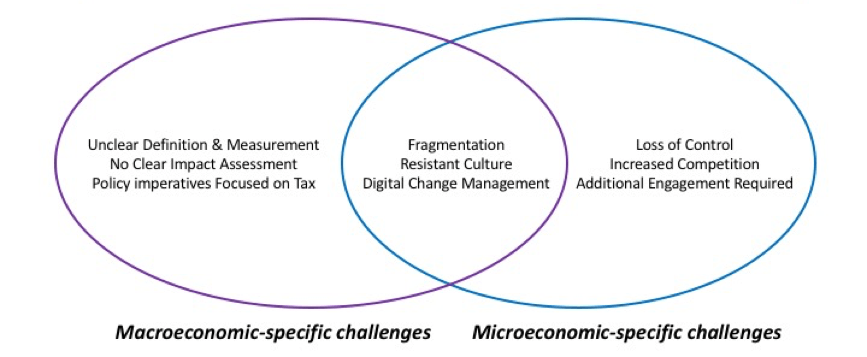Introduction
The challenges of digitizing services are multiple; however, the benefits are considerable if successful. It has been called “one of the biggest opportunities and challenges facing enterprises — and their CIOs — today” (Weill & Woerner, 2013). Defined as “the practice of taking processes, content or objects that used to be primarily (or entirely) physical or analog and transforming them to be primarily (or entirely) digital” (Fichman et al. 2014), Dilmegani, Korkmaz, & Lundqvist, (2014) suggest that capturing the full potential of government digitization could free up to $1 trillion annually in economic value worldwide, through improved cost and operational performance. It is, therefore, a topic worth investigating from multiple perspectives.
Macroeconomic Level
At the national (macroeconomic) level, the challenges associated with digitization include: unclear definitions and measurements of digitization, a lack of digitization impact assessment tools assessing the impact of digitization, and policy imperatives focused on taxation of information and communications technology (ICT), not digitization (Sabbagh, El-Darwiche, Friedrich, & Singh, 2012).
Unclear Definition And Measurement Of Digitization.
Policymakers must understand that the environment for ICT has changed significantly from the one for which the original policies were designed (Sabbagh, et al., 2012). Further, the concept of digitization is poorly understood; there is a misunderstanding that digitization equates to broadband access when in reality, there are significant benefits linked to growing usage of digital technologies and applications beyond access alone (Sabbagh, et al., 2012). One of the effects of digitizing services and processes – in addition to potential efficiency gains – is making processes more tailorable and malleable (Fichman et al. 2014). Once the concept of digitization is understood, the question shifts to a matter of assessing assimilation of ICT within a society. A significant challenge is the lack of established standard performance indicators to measure the extent to which ICT is being assimilated in societies (Sabbagh, et al., 2012). There are some tentative guidelines that can be used by countries to develop a preliminary understanding of where they measure in relation to others. Therefore, the first challenge is the defining and assessment of the adoption of ICT within a society.
Lack Of Digitization Impact Assessment Tools.
The second challenge lay in the lack of tools to determine the impact that the mass adoption of connected digital technologies and applications is having on societies and economies (Sabbagh, et al., 2012). Sabbagh, et al. (2012) noted that “countries that have achieved advanced levels of digitization (the mass adoption of connected digital technologies and applications by consumers, enterprises, and governments) have realized significant benefits in their economies, their societies, and the functioning of their public sectors.” Indeed, countries at the most advanced stage of digitization derive 20 percent more in economic benefits than those at the initial stage (Sabbagh, et al., 2012). As such, while it is difficult to measure, there is already evidence to demonstrate that it is beneficial to implement a strong national digitization strategy.
Policy Imperatives Focused on Taxation of ICT.
If the first two issues are resolved (defining and measuring the degree of digitization, assessing the impact of digitization), it is possible to create evidence-based policy that prioritizes digitization. This will require a shift in thinking for less-digitized countries. While advanced societies view it as an enabler of socio-economic development, developing countries still struggle to view the sector as anything more than a source of tax revenue (Sabbagh, et al., 2012). Until countries recognize the importance of the ICT sector for overall economic growth and adjust their policies accordingly, digitization will not be a priority and policymakers will not focus on adopting new policy tools to accelerate digitization and reap its accompanying benefits (Sabbagh, et al., 2012).
Microeconomic Level
At the organizational (microeconomic) level there are other implications of digital change, including: the loss of control over the customer relationship, increased competition and threat of commoditization, and the need to engage digitally with suppliers, partners and employees in addition to customers (EY, 2011). Irrespective of whether an organization is private or public, there are several challenges associated with the digitization of services, including: fragmentation, resistant culture, and digital change management.
Digitizing Services: Fragmentation
Dilmegani, Korkmaz, & Lundqvist (2014) indicate that silos, fragmentation, and the absence of a central owner for IT infrastructure and common components can make it hard to create a seamless experience for the end-user. The implementation will not be successful if an analog company starts hiring new staff to implement digital solutions, but creates a digital silo for the new employees (Harshak, Schmaus, & Dimitrova, 2013). To be successful, companies need to develop a comprehensive ‘digital strategy’ that reaches far beyond the marketing department to tackle issues like ubiquitous cross-channel connectivity, social commerce, and the threat of commoditization (EY, 2011). Without innovation strategies, companies will lose their competitive advantage in an increasingly commoditised world (EY, 2011). These strategies must transcend all silos, becoming part of the overall business plan.
Digitizing Services: Resistant Culture
If an organization can avoid silos and fragmentation, they may not be able to avoid the effects of a resistant culture. Even well-designed systems can be undermined by a company’s established culture (Harshak, Schmaus, & Dimitrova, 2013), often referred to as “the way things are done here.” Cultural resistance can be embedded throughout the company; for example, through the reluctance of individuals to adopt new technology, indicating that it is “not applicable” to their domain. Indicators of resistance to digitization can be identified through multiple means, including uncovering the attitudes held by different divisions about each other and in sales incentive structures, which are often geared to the status quo (Harshak, Schmaus, & Dimitrova, 2013). It is important to be mindful of organizational culture and work towards incremental changes, engaging the workforce in this transition to ensure it is successful.
Digitizing Services: Change Management
Change can be difficult in established organizations with a strong culture, and finding someone to lead a digital change management strategy is critical to the overall success. Unfortunately, the rate of change continues to increase exponentially due to Moore’s law and increased adoption (Fichman et al. 2014) and a background in computer science or business is insufficient in meeting the demands of managing digitization and digital innovation. If IT is a driver of process innovation within firms, Fischeman et al. (2014) indicate that a better grounding on how to manage “new ways of doing things in an organizational setting, and as such, the term encompasses not just new business processes, but also the creation of new capabilities, strategies, and structures that are in some way digitally-enabled” will be required. Unfortunately, at many schools, the required Information Systems (IS) core class is not very effective at teaching aspiring managers what they most need to know about digital innovation (Fichman et al. 2014). Knowing about the especially high switching costs often imposed by digital products and processes (Shapiro and Varian 1999) is important, and knowing how leveraging digitization to provide an enhanced product or service at a lower cost equally so.

Figure 1 – Challenges with Digitization
Discussion
We have identified macro and microeconomic challenges related to the digitization of services, as well as challenges common to both levels. While there are many challenges associated with digitization of services, they can be mitigated. The six most important levers identified by McKinsey & Company (2014) as being applicable in both the public and the private sector in relation to digitization are as follows: (1) Win organization-wide and department-deep commitment to specific digital targets. (2) Establish organization-wide coordination of IT investments. (3) Redesign processes with the end user in mind. (4) Hire and nurture the right talent. (5) Use big data and analytics to improve decision making. (6) Protect critical infrastructure and confidential data. Their report contains many stories and anecdotes that help illustrate these points. For example, an option for organizations that are looking to ‘experiment’ with digital business models is to spin off smaller businesses in order to learn how to take advantage of the new digital world (EY, 2011). This permits the primary company to maintain their focus while testing out innovative new business models in a contained environment. In short, there are many models and potential solutions from which an organization may begin their march towards digitization of services after appropriate review of suitability within their environment–it is a matter of willingness of the organizations to face the challenges, in the expectation of great rewards.
Conclusion: Digitizing Services
There is no time to lose–Countries and companies that have digitized are already reaping the rewards of this transition, technology change is accelerating exponentially and new digital platforms and devices are emerging. The failure in recent years of multiple bricks-and-mortar stores (such as Blockbuster filing for bankruptcy in 2013) simply serves to highlight this issue and its importance. At the macroeconomic level, the benefits are significant to economies, societies, and the functioning of their public sectors. At the microeconomic level, digitization can help prevent the failure of established businesses and help new businesses establish themselves over less agile incumbents. This can be done by defining and measuring digitization, assessing the impact of digitization, and developing policy imperatives (Sabbagh, et al., 2012). Without these clear steps, the potential benefits of digitization will be lost to all members and levels of society.
References
Ardichvili, A., Page, V., & Wentling, T. 2003. Motivation and barriers to participation in virtual knowledge-sharing communities of practice. Journal of Knowledge Management, 7(1): 64–77.
Brandt, R. 1995. Punished by rewards. Educational Leadership: Journal of the Department of Supervision and Curriculum Development, N.E.A, 53(1): 13–16.
Chaudhary, N., & Bowles, N. 2006. Commercial Tree Nursery Industry. Government of Alberta. http://www1.agric.gov.ab.ca/$department/deptdocs.nsf/all/agdex1370#1.
Chiu, C.-M., Hsu, M.-H., & Wang, E. T. G. 2006. Understanding knowledge sharing in virtual communities: An integration of social capital and social cognitive theories. Decision Support Systems, 42(3): 1872–1888.
Christensen, C. M. 1997. When New Technologies Cause Great Firms to Fail. Boston, Massachusetts: Harvard Business School Press.
Conway, P. 2010. Preservation in the Age of Google: Digitization, Digital Preservation, and Dilemmas. The Library Quarterly: Information, Community, Policy, 80(1): 61–79.
Cummings, J. L., & Holmberg, S. R. 2012. Best-fit Alliance Partners: The Use of Critical Success Factors in a Comprehensive Partner Selection Process. Long Range Planning, 45(2–3): 136–159.
Dilmegani, C., Korkmaz, B., & Lundqvist, M. 2014, December. Public-sector digitization: The trillion-dollar challenge | McKinsey & Company. http://www.mckinsey.com/business-functions/business-technology/our-insights/public-sector-digitization-the-trillion-dollar-challenge.
Fichmann, R. G., Dos Santos, B. L., & & Zheng, Z. 2014. Digital innovation as a fundamental and powerful concept in the information systems curriculum. MIS Quarterly, 38(2): 329–353.
Giordullo, S. 2015, April 17. How Much Do Trees Cost? Angie’s List | Find a Local Business, Ratings, Reviews, Deals. https://www.angieslist.com/articles/how-much-do-trees-cost.htm.
Harshak, A., Schmaus, B., & Dimitrova, D. 2013. Building a digital culture: How to meet the challenge of multichannel digitization. PwC. https://www.lizlance.ca/wp-content/uploads/2023/01/strategyand-building-a-digital-culture.pdf.
Hienerth, C., Lettl, C., & Keinz, P. 2014. Synergies among Producer Firms, Lead Users, and User Communities: The Case of the LEGO Producer–User Ecosystem. Journal of Product Innovation Management, 31(4): 848–866.
Hossain, M. 2012. Users’ motivation to participate in online crowdsourcing platforms. Innovation Management and Technology Research (ICIMTR), 2012 International Conference on, 310–315.
Kleinginna, P. R., Jr, & Kleinginna, A. M. 1981. A categorized list of motivation definitions, with a suggestion for a consensual definition. Motivation and Emotion, 5(3): 263–291.
Kohn, A. 1999. Punished by rewards: The trouble with gold stars, incentive plans, A’s, praise, and other bribes. Houghton Mifflin Harcourt.
Leimeister, J. M., Huber, M., Bretschneider, U., & Krcmar, H. 2009. Leveraging Crowdsourcing: Activation-Supporting Components for IT-Based Ideas Competition. Journal of Management Information Systems, 26(1): 197–224.
Mahr, D., & Lievens, A. 2012. Virtual lead user communities: Drivers of knowledge creation for innovation. Research Policy, 41(1): 167–177.
Moore, T. D., & Serva, M. A. 2007. Understanding Member Motivation for Contributing to Different Types of Virtual Communities: A Proposed Framework. Proceedings of the 2007 ACM SIGMIS CPR Conference on Computer Personnel Research: The Global Information Technology Workforce, 153–158. New York, NY, USA: ACM.
O’Neil, J., & Tell, C. 1999. Why students lose when “tougher standards” win: A conversation with Alfie Kohn. Educational Leadership: Journal of the Department of Supervision and Curriculum Development, N.E.A, 57: 18–23.
Partanen, J., & Möller, K. 2012. How to build a strategic network: A practitioner-oriented process model for the ICT sector. Industrial Marketing Management, 41(3): 481–494.
Prahalad, C. K., & Ramaswamy, V. 2004. Co-creating unique value with customers. Strategy & Leadership. http://www.emeraldinsight.com/doi/abs/10.1108/10878570410699249.
Prahalad, C. K., & Hamel, G. 1990. The core competence of the corporation. Harvard Business Review, 79–91.
Sabbagh, K., El-Darwiche, B., Friedrich, R. & Singh, M. 2012. Maximizing the Impact of Digitization. no. Strategy&, PwC.
Von Hippel, E. A. 2005. Democratizing Innovation. Cambridge, MA: MIT Press.
Wallin, C. 2012a. Growing trees for profit.
Wallin, C. 2012b. How to Make $40,000 (Or More) Growing Potted Trees. http://www.profitableplantsdigest.com/how-to-make-40000-or-more-growing-potted-trees/.
Wasko, M. M., & Faraj, S. 2005. Why should I share? Examining social capital and knowledge contribution in electronic networks of practice. MIS Quarterly, 29(1): 35.
Weill, P., & Woerner, S. 2013. Is Your Organization Ready for Total Digitization? Harvard Business Review (HBR) Blog, July 24th. https://hbr.org/2013/07/is-your-organization-ready-for.
Wooder, S., & Baker, S. 2012. Extracting Key Lessons in Service Innovation. Journal of Product Innovation Management, 29(1): 13–20.
Trees | US Forest Service. n.d.. http://www.fs.fed.us/learn/trees, April 16, 2016.
The digitisation of everything: How organisations must adapt to changing consumer behaviour. 2011.. Ernst & Young. http://www.ey.com/Publication/vwLUAssets/The_digitisation_of_everything_-_How_organisations_must_adapt_to_changing_consumer_behaviour/$FILE/EY_Digitisation_of_everything.pdf.
#CES 2015 : Parrot Pot, the most advanced connected plant pot – Parrot news. 2015, January 5. Parrot news. http://blog.parrot.com/2015/01/05/ces-2015-flower-power-pot-the-smart-pot-that-grows-healthy-plant/.
Greenhouse, sod and nursery industries. 2004.. Statistics Canada. http://www.statcan.gc.ca/daily-quotidien/050422/dq050422e-eng.htm.


0 Comments